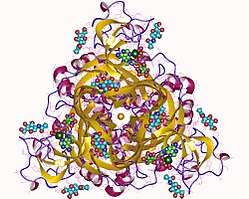P2RX3
P2X purinoceptor 3 is a protein that in humans is encoded by the P2RX3 gene.[5][6]
The product of this gene belongs to the family of purinoceptors for ATP. This receptor functions as a ligand-gated ion channel and may transduce ATP-evoked nociceptor activation. Mouse studies suggest that this receptor is important for peripheral pain responses, and also participates in pathways controlling urinary bladder volume reflexes, platelet aggregation, macrophage activation, apoptosis and neuronal–glial interactions. It is possible that the development of selective antagonists for this receptor may have a therapeutic potential in pain relief and in the treatment of disorders of urine storage.[6]
See also
References
- 1 2 3 GRCh38: Ensembl release 89: ENSG00000109991 - Ensembl, May 2017
- 1 2 3 GRCm38: Ensembl release 89: ENSMUSG00000027071 - Ensembl, May 2017
- ↑ "Human PubMed Reference:".
- ↑ "Mouse PubMed Reference:".
- ↑ Garcia-Guzman M, Stuhmer W, Soto F (Sep 1997). "Molecular characterization and pharmacological properties of the human P2X3 purinoceptor". Brain Res Mol Brain Res. 47 (1–2): 59–66. doi:10.1016/S0169-328X(97)00036-3. PMID 9221902.
- 1 2 "Entrez Gene: P2RX3 purinergic receptor P2X, ligand-gated ion channel, 3".
Further reading
- North RA (2002). "Molecular physiology of P2X receptors". Physiol. Rev. 82 (4): 1013–67. doi:10.1152/physrev.00015.2002. PMID 12270951.
- Jarvis MF (2005). "Contributions of P2X3 homomeric and heteromeric channels to acute and chronic pain". Expert Opin. Ther. Targets. 7 (4): 513–22. doi:10.1517/14728222.7.4.513. PMID 12885270.
- Kennedy C, Leff P (1995). "Painful connection for ATP". Nature. 377 (6548): 385–6. doi:10.1038/377385a0. PMID 7566110.
- Lewis C, Neidhart S, Holy C, et al. (1995). "Coexpression of P2X2 and P2X3 receptor subunits can account for ATP-gated currents in sensory neurons". Nature. 377 (6548): 432–5. doi:10.1038/377432a0. PMID 7566120.
- Garcia-Guzman M, Soto F, Gomez-Hernandez JM, et al. (1997). "Characterization of recombinant human P2X4 receptor reveals pharmacological differences to the rat homologue". Mol. Pharmacol. 51 (1): 109–18. PMID 9016352.
- Cook SP, McCleskey EW (2000). "ATP, pain and a full bladder". Nature. 407 (6807): 951–2. doi:10.1038/35039648. PMID 11069162.
- Strausberg RL, Feingold EA, Grouse LH, et al. (2003). "Generation and initial analysis of more than 15,000 full-length human and mouse cDNA sequences". Proc. Natl. Acad. Sci. U.S.A. 99 (26): 16899–903. doi:10.1073/pnas.242603899. PMC 139241. PMID 12477932.
- Renton T, Yiangou Y, Baecker PA, et al. (2003). "Capsaicin receptor VR1 and ATP purinoceptor P2X3 in painful and nonpainful human tooth pulp". Journal of orofacial pain. 17 (3): 245–50. PMID 14520770.
- Mason HS, Bourke S, Kemp PJ (2005). "Selective modulation of ligand-gated P2X purinoceptor channels by acute hypoxia is mediated by reactive oxygen species". Mol. Pharmacol. 66 (6): 1525–35. doi:10.1124/mol.104.000851. PMID 15331767.
- Fabbretti E, Sokolova E, Masten L, et al. (2005). "Identification of negative residues in the P2X3 ATP receptor ectodomain as structural determinants for desensitization and the Ca2+-sensing modulatory sites". J. Biol. Chem. 279 (51): 53109–15. doi:10.1074/jbc.M409772200. PMID 15475563.
- Brown DA, Yule DI (2007). "Protein kinase C regulation of P2X3 receptors is unlikely to involve direct receptor phosphorylation". Biochim. Biophys. Acta. 1773 (2): 166–75. doi:10.1016/j.bbamcr.2006.09.020. PMC 1861828. PMID 17052768.
External links
- P2RX3+protein,+human at the US National Library of Medicine Medical Subject Headings (MeSH)
This article incorporates text from the United States National Library of Medicine, which is in the public domain.




